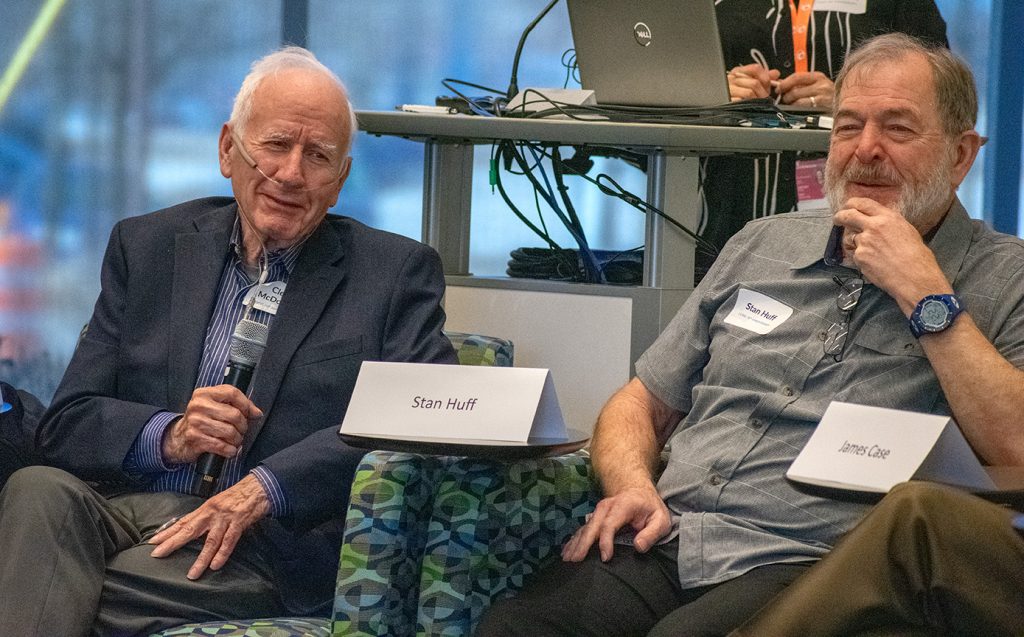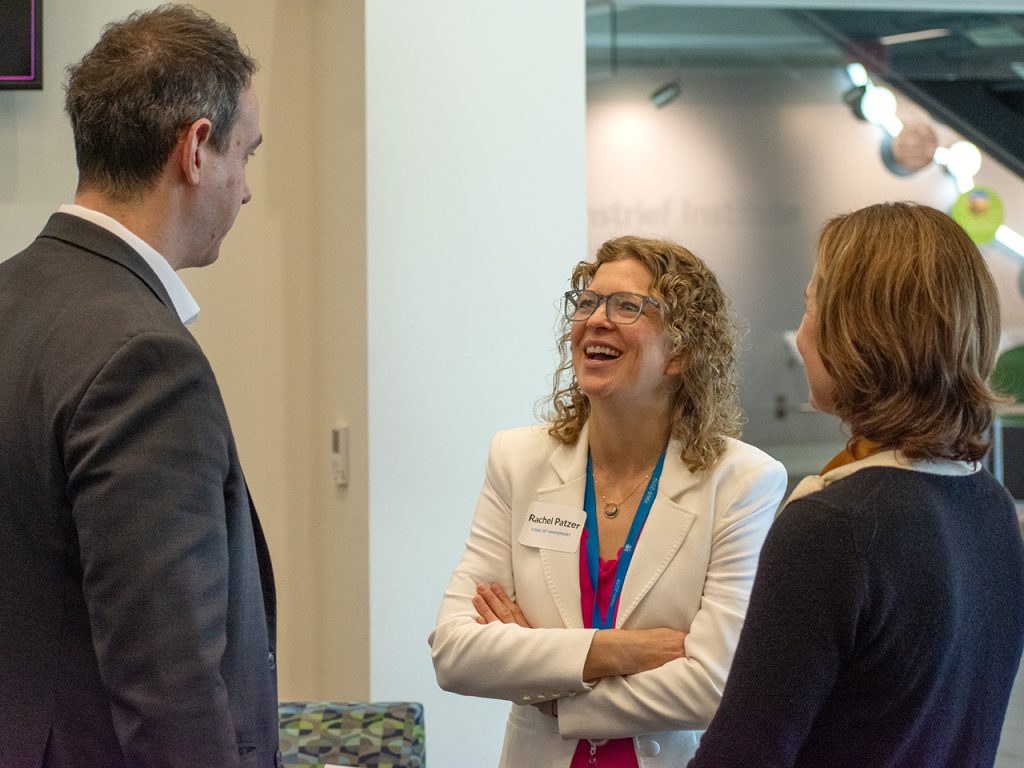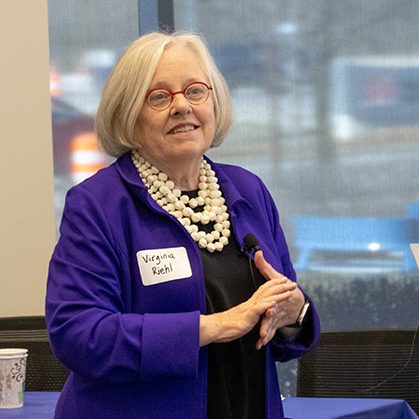 LOINC® from Regenstrief Institute observed its 30th anniversary with a reception and wide-ranging professional discussions on Wednesday, Feb. 14, 2024, at the Regenstrief Institute.
LOINC® from Regenstrief Institute observed its 30th anniversary with a reception and wide-ranging professional discussions on Wednesday, Feb. 14, 2024, at the Regenstrief Institute.
LOINC, the most accepted international terminology standard enabling the identification, exchange and collection of data across health systems, is used in nearly every country around the world. This lingua franca, critical to computerized transmission and seamless exchange of medical information, was created and is maintained at Regenstrief Institute, supported by a very active user community.
 An acronym for Logical Observation Identifiers Names and Codes, LOINC is a global standard for identifying health measurements, observations and documents. Using LOINC, the results of the same cholesterol level test, or the same clinical observation blood pressure reading, for example, can be compared by different institutions for the purposes of patient care, research, quality assessment or outcomes management.
An acronym for Logical Observation Identifiers Names and Codes, LOINC is a global standard for identifying health measurements, observations and documents. Using LOINC, the results of the same cholesterol level test, or the same clinical observation blood pressure reading, for example, can be compared by different institutions for the purposes of patient care, research, quality assessment or outcomes management.
Opening remarks at the event were provided by Marjorie Rallins, DPM, M.S., executive director, Health Data Standards, Regenstrief Institute; and Rachel Patzer, PhD, MPH, president and chief executive officer, Regenstrief Institute.


LOINC’s origin can be traced back to pioneering work by Regenstrief Institute research scientists, led during its early years by principal founder Clement McDonald, M.D.
Reflections from founders and early supporters were presented in remarks to the audience. They included:
- McDonald, chief health data standards officer, National Institutes of Health’s National Library of Medicine.
- Stan Huff, M.D., chief medical informatics officer, Graphite Health.
- James Case, DVM, chief terminologist, SNOMED International.
- Ed Hammond, PhD, director, Duke Center for Health Informatics.
- Betsy Humphreys, retired deputy director, NIH’s National Library of Medicine.
- Dan Vreeman, P.T., DPT, M.S., chief standards development officer, HL7®.
 Further observations and discussions were provided by participants in the LOINC implementer panel. Topics discussed included challenges that LOINC has solved and next steps for the worldwide standard. Speakers included:
Further observations and discussions were provided by participants in the LOINC implementer panel. Topics discussed included challenges that LOINC has solved and next steps for the worldwide standard. Speakers included:
- James J. Cimino, M.D., distinguished professor and chair, Biomedical Informatics and Data Science, Heersink School of Medicine, University of Alabama at Birmingham.
- Burke Mamlin, M.D., associate professor of clinical medicine, Indiana University School of Medicine; research scientist, Regenstrief Institute; program director, Regenstrief Clinical Informatics Fellowship and co-founder, OpenMRS, Global Health Informatics, Clem McDonald Center for Biomedical Informatics.
- Mark Roche, M.D., executive director, Health Informatics, Syntropy.
- Corey Smith, M.S., vice president, Informatics and Digital Products, American Medical Association.
- Steve Emrick, vice president, Strategic Client Success, Clinical Architecture.
- Victor Lee, M.D., vice president, Clinical Informatics, Clinical Architecture.
- Susan Matney, PhD, RNC-OB, informatics consultant, Wise Owl Originals LLC.
 Additional discussion followed, facilitated by Virginia Riehl, a healthcare management consultant who has worked with LOINC, federal agencies and health information exchange and healthcare information technology for decades. A celebratory toast was given by William (Bill) M. Tierney, M.D., associate dean for Population Health and Health Outcomes and clinical professor, Department of Community and Global Health, IU Fairbanks School of Public Health. Dr. Tierney is a longtime Regenstrief colleague of Dr. McDonald.
Additional discussion followed, facilitated by Virginia Riehl, a healthcare management consultant who has worked with LOINC, federal agencies and health information exchange and healthcare information technology for decades. A celebratory toast was given by William (Bill) M. Tierney, M.D., associate dean for Population Health and Health Outcomes and clinical professor, Department of Community and Global Health, IU Fairbanks School of Public Health. Dr. Tierney is a longtime Regenstrief colleague of Dr. McDonald.
Regenstrief collaborates with other major players in the healthcare data space to broaden LOINC adoption, including via a long-term agreement with SNOMED International. In December 2023, LOINC received a $4.4 million award from the Regenstrief Foundation to support work to categorize and standardize social determinants of health data in electronic medical records. The work is led by the Health Data Standards unit at Regenstrief and HL7’s Gravity Project.
 With its 30-year history of enabling efficient transmission, understanding and, most importantly, use of data to improve human health and quality of life, LOINC is poised to help individuals and populations live longer and better lives in the future.
With its 30-year history of enabling efficient transmission, understanding and, most importantly, use of data to improve human health and quality of life, LOINC is poised to help individuals and populations live longer and better lives in the future.
About LOINC® from Regenstrief
LOINC was created in 1994 at Regenstrief Institute in an effort to facilitate interoperability in healthcare. Today, the LOINC coding system contains more than 100,000 terms for everything from a serum alpha 1 antitrypsin level to a zygomatic arch x-ray report. For each concept, LOINC covers many other rich details, such as synonyms, units of measure and carefully crafted descriptions. With long-term funding support from U.S. federal agencies and other organizations, LOINC is available free of charge.










